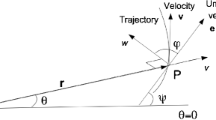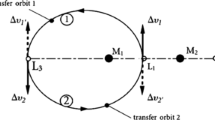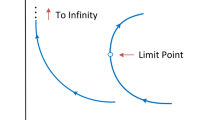Abstract
The Hohmann transfer theory, developed in the 19th century, is the kernel of orbital transfer with minimum propellant mass by means of chemical engines. The success of the Deep Space 1 spacecraft has paved the way toward using advanced electrical engines in space. While chemical engines are characterized by high thrust and low specific impulse, electrical engines are characterized by low thrust and hight specific impulse. In this paper, we focus on four issues of optimal interplanetary transfer for a spacecraft powered by an electrical engine controlled via the thrust direction and thrust setting: (a) trajectories of compromise between transfer time and propellant mass, (b) trajectories of minimum time, (c) trajectories of minimum propellant mass, and (d) relations with the Hohmann transfer trajectory. The resulting fundamental properties are as follows:
-
(a) Flight Time/Propellant Mass Compromise. For interplanetary orbital transfer (orbital period of order year), an important objective of trajectory optimization is a compromise between flight time and propellant mass. The resulting trajectories have a three-subarc thrust profile: the first and third subarcs are characterized by maximum thrust; the second subarc is characterized by zero thrust (coasting flight); for the first subarc, the normal component of the thrust is opposite to that of the third subarc. When the compromise factor shifts from transfer time (C=0) toward propellant mass (C=1), the average magnitude of the thrust direction for the first and third subarcs decreases, while the flight time of the second subarc (coasting) increases; this results into propellant mass decrease and flight time increase.
-
(b) Minimum Time. The minimum transfer time trajectory is achieved when the compromise factor is totally shifted toward the transfer time (C=0). The resulting trajectory is characterized by a two-subarc thrust profile. In both subarcs, maximum thrust setting is employed and the thrust direction is transversal to the velocity direction. In the first subarc, the normal component of the thrust vector is directed upward for ascending transfer and downward for descending transfer. In the second subarc, the normal component of the thrust vector is directed downward for ascending transfer and upward for descending transfer.
-
(c) Minimum Propellant Mass. The minimum propellant mass trajectory is achieved when the compromise factor is totally shifted toward propellant mass (C=1). The resulting trajectory is characterized by a three-subarc (bang-zero-bang) thrust profile, with the thrust direction tangent to the flight path at all times.
-
(d) Relations with the Hohmann Transfer. The Hohmann transfer trajectory can be regarded as the asymptotic limit of the minimum propellant mass trajectory as the thrust magnitude tends to infinity. The Hohmann transfer trajectory provides lower bounds for the propellant mass, flight time, and phase angle travel of the minimum propellant mass trajectory.
The above properties are verified computationally for two cases (a) ascending transfer from Earth orbit to Mars orbit; and (b) descending transfer from Earth orbit to Venus orbit. The results are obtained using the sequential gradient- restoration algorithm in either single-subarc form or multiple-subarc form.
Similar content being viewed by others
References
G. Walberg (1993) ArticleTitleHow Shall We Go to Mars? A Review of Mission Scenarios Journal of Spacecraft and Rockets 30 IssueID2 129–139
W. J. O’Neil C. Cazaux (2000) ArticleTitleMars Sample Return Project Acta Astronautica 47 IssueID2 453–465
A. Miele T. Wang (1999) ArticleTitleOptimal Tranfers from an Earth Orbit to a Mars Orbit Acta Astronautica 45 IssueID3 119–133 Occurrence Handle10.1016/S0094-5765(99)00109-5 Occurrence Handle1727256
A. Miele T. Wang (1999) ArticleTitleOptimal Trajectories and Mirror Properties for Round-Trip Mars Missions Acta Astronautica 45 IssueID11 655–668 Occurrence Handle10.1016/S0094-5765(99)00117-4
A. Miele T. Wang S. Mancuso (2000) ArticleTitleOptimal Free-Return Trajectories for Moon Missions and Mars Missions Journal of the Astronautical Sciences 48 IssueID2–3 183–206
A. Miele T. Wang S. Mancuso (2000) Fundamental Issues of Orbital Transfers for Mars Missions 51st International Astronautical Congress Rio de Janeiro, Brazil
A. Miele T. Wang S. Mancuso (2001) ArticleTitleAssesment of Launch Vehicle Advances to Enable Human Mars Excursions Acta Astronautica 49 IssueID11 563–580 Occurrence Handle10.1016/S0094-5765(01)00008-X
A. Gipsman M. Guelman A. Kogan (1999) ArticleTitleAutonomous Navigation and Guidance System for Low-Thrust Driven Deep Space Missions Acta Astronautica 44 IssueID7 353–364 Occurrence Handle10.1016/S0094-5765(99)00058-2
M. D. Rayman P. A. Chadbourne J. S. Culwell S. N. Williams (1999) ArticleTitleMission Design for Deep Space 1: A Low-Thrust Technology Validation Mission Acta Astronautica 45 IssueID4 381–388 Occurrence Handle10.1016/S0094-5765(99)00157-5
G. B. Ganapathi C. S. Engelbrecht (2000) ArticleTitlePerformance of the Xenon Feed System on Deep Space One. Journal of Spacecraft and Rockets 37 IssueID3 392–398
A. Axelrod M. Guelman D. Mishne (2002) ArticleTitleOptimal Control of Interplanetary Trajectories Using Electrical Propulsion with Discrete Thrust Levels Journal of Guidance, Control, and Dynamics 25 IssueID5 932–939
S. N. Williams V. Coverstone-Carroll (2000) ArticleTitleMars Missions Using Solar-Electric Propulsion Journal of Spacecraft and Rockets 37 IssueID1 71–77
S. R. Vadali R. Nah E. Braden I. L. Johnson (2000) ArticleTitleFuel-Optimal Planar Earth-Mars Trajectories Using Low-Thrust Exhaust-Modulated Propulsion Journal of Guidance, Control and Dynamics 23 IssueID3 476–482
A. L. Herman D. B. Spencer (2002) ArticleTitleOptimal Low-Thrust Earth-Orbit Transfers Using Higher-Order Collocation Methods Journal of Guidance, Control, and Dynamics 25 IssueID1 40–47
L. M. Mailhe S. D. Heister (2002) ArticleTitleDesign of aHybrid Chemical/Electrical Propulsion Orbital Transfer Vehicle Journal of Spacecraft and Rockets 39 IssueID1 131–139 Occurrence Handle10.2514/2.3791
R. Bertrand J. Bernussou S. Geffroy R. Epenoy (2001) ArticleTitleElectric Transfer Optimization for Mars Sample Return Mission Acta Astronautica 48 IssueID5–12 651–660
Miele, A., Wang, T., and Williams, P. N., Computation of Optimal Trajectories via Combined Chemical/Electrical Propulsion, Part 1: Baseline Solutions for Deep Interplanetary Space, Paper IAC-02-A.6.05, 53rd International Astronautical Congress, Houston, Texas, 2002.
Miele, A., Wang, T., and Williams, P. N., Computation of Optimal Trajectories via Combined Chemical/Electrical Propulsion, Part 2: Minimum Time Solutions with Bounded Thrust Direction, Paper AAS-03-121, 13th Annual AAS/AIAA Space Flight Mechanics Meeting, Ponce, Puerto Rico, 2003
A. Miele T. Wang P.N. Williams (2003) Computation of Optimal Trajectories via Combined Chemical/Electrical Propulsion, Part 3: Compromise Solutions. AAS/AIAA Astrodynamics Specialist Conference Big Sky Montana
A. Miele R. E. Pritchard I. N. Damoulakis (1970) ArticleTitleSequential Gradient-Restoration Algorithm for Optimal Control Problems Journal of Optimization Theory and Applications 5 IssueID4 235–282 Occurrence Handle10.1007/BF00927913 Occurrence Handle266402 Occurrence Handle0192.51802
A. Miele T. Wang V. K. Basapur (1986) ArticleTitlePrimal and Dual Formulations of Sequential Gradient-Restoration Algorithms for Trajectory Optimization Problems Acta Astronautica 13 IssueID8 491–505 Occurrence Handle10.1016/0094-5765(86)90028-7 Occurrence Handle0619.70028
B. H. Rishikof B. R. McCormick R. E. Pritchard S. J. Sponaugle (1992) ArticleTitleSEGRAM: A Practical and Versatile Tool for Spacecraft Trajectory Optimization Acta Astronautica 26 IssueID8–10 599–609
Miele, A., and Wang, T., Multiple-Subarc Sequential Gradient-Restoration Algorithm and Applicaton to a Multistage Launch Vehicle Design, Paper Presented at the 6th SIMAI National Congress, Chia Laguna, Cagliari, Italy, 27–31 May 2002.
A. Miele T. Wang (2003) ArticleTitleMultiple-Subarc Sequential Gradient-Restoration Algorithm, Part 1: Algorithm Structure Journal of Optimization Theory and Applications 116 IssueID1 1–17 Occurrence Handle1961025 Occurrence Handle1029.49030
A. Miele T. Wang (2003) ArticleTitleMultiple-Subarc Sequential Gradient-Restoration Algorithm, Part 2: Application to a Multistage Launch Vehicle Design Journal of Optimization Theory and Applications 116 IssueID1 19–39 Occurrence Handle1961026 Occurrence Handle1029.49031
A. Miele (1962) Flight Mechanics 1: Theory of Flight Paths Addison-Wesley Publishing Company Reading, Massachusetts
A. Miele M. Ciarcia J. Mathwig (2004) ArticleTitleReflections on the Hohmann Transfer Journal of Optimization Theory and Applications 123 IssueID2 233–253 Occurrence Handle10.1007/s10957-004-5147-z Occurrence Handle2101404
Author information
Authors and Affiliations
Additional information
Portions of this paper were presented by the senior author at the 54th International Astro-nautical Congress, Bremen, Germany, 29 September–3 October 2003 (Paper IAC-03-A.7.02).
This research was supported by NSF Grant CMS-02-18878 and NSF Cooperative Agreement HRD-98-17555 as part of the Rice University AGEP Program.
Rights and permissions
About this article
Cite this article
Miele, A., Wang, T. & Williams, P.N. Optimal Interplanetary Orbital Transfers via Electrical Engines. J Optim Theory Appl 127, 605–625 (2005). https://doi.org/10.1007/s10957-005-7506-9
Issue Date:
DOI: https://doi.org/10.1007/s10957-005-7506-9




